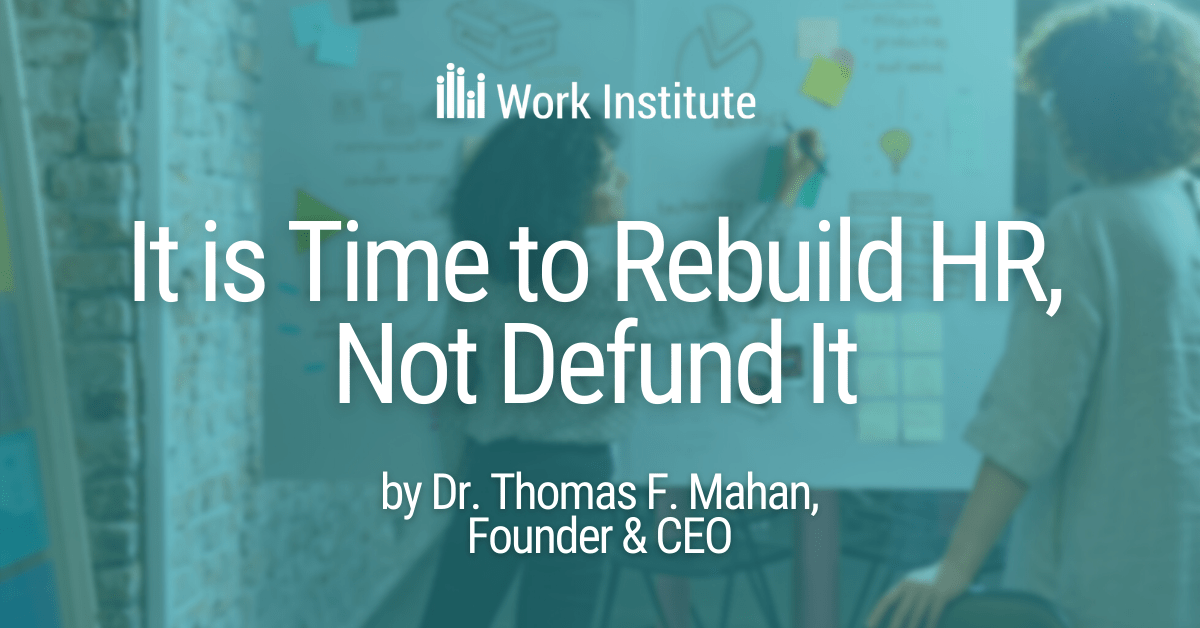There is considerable talk these days that HR does not deliver the value of its capability. Additional arguments include moving HR functions into Legal, Finance, and both internal and external Marketing/Communications.
Should HR functions be reassigned or defunded? Can HR deliver the value it is designed to provide?
The real question is whether HR has the time and resources necessary to respond to the strategic challenges in this unusual and highly competitive market. Today’s challenge is the job market and turnover. The pandemic is hopefully under control and economic recovery is moving forward. An obvious consequence of this recover includes the opportunity for employees to find jobs elsewhere.
- Is it Management’s preference to decline knowing the real reasons for employees staying and quitting because they are otherwise busy?
- Is it HR’s preference to decline knowing the real reasons for employees staying and quitting because they are too cozy with the state of chaos vacancies and turnover creates?
- Does HR believe that building larger recruiting teams (to compensate for increasing turnover) makes them more valuable to the organization?
- Is Management pursuing their own self-fulfillment by ordering solutions and providers that biases dictate?
Productivity, a financial measure, improves when organizational dollars produce more profit with the same or less expense. Productivity worsens when organizational dollars produce less profit with more expense.
Current trends show the competition for workers is escalating while the talent pool is shrinking. This intensifies an employee-in-control marketplace and places employers at risk of rising turnover costs. As workers leave their jobs, employers incur direct costs associated with separation, replacement, and training and indirect costs through decreased organizational performance.
Achieving business results in this intensely competitive employee marketplace demands that employers take measures to predict and prevent turnover. Implemented effectively, human capital costing, employee-centric research, and evidence-based intervention provides cost savings, and increases productivity.
Defunding is not the answer. We should rebuild HR instead Here’s how:
First and foremost, conduct a thorough assessment:
What is your current spending (budget) on recruiting for positions that are too often vacated? What are you currently spending (budgeting) for turnover? When an organization budgets 20 % for scrap, you get 20% scrap. The same goes for turnover. Budget 30% turnover and you will get it, and more. Defund your budget. Know your costs and set responsible reductions for attraction and retention expenses.
Turnover is waste. Quit budgeting waste.
Learn from employees. Know the real reasons. What attracts them to your organization? What are the real reasons they intend to leave? What are the real reasons they actually leave? Properly conducted Recruitment Studies, Stay Interviews, and Exit Interviews map a productivity journey worth taking. Only when attraction and retention is well understood is a solution possible.
Secondly, organizations need to confront and accept change requirements:
Be wary of availability bias, self-serving bias, and confirmation bias. Just because the organization has a leadership development curriculum does not mean this is the correct solution for retention. Do not confuse availability with causality.
- Just because you are an expert in compensation design does not mean you need to adjust compensation.
- Just because your favorite media outlet, manager, or consultant says it is a generational problem, does not make it so.
Design the attraction and retention strategy based on responsible data provided by current and former employees, not some outside influence. The current and former employees are the experts. Employee “Best Practices” come from within.
Finally, move forward with a Just-In-Time (JIT) Solution Methodology
Know the business case for Attraction and Retention Management.
- Employee recruitment and turnover costs are on the rise as an employee-in-control marketplace intensifies, making it critical for organizations to proactively understand the intents of the workforce and prevent turnover to protect profits.
- As steps are taken to effectively understand potential and incumbent employees and predict turnover, organizations can accurately identify necessary solutions.
The value of data lies in identifying solutions for improvement. There are three internal actions essential to effectively retain employees.
- Management commitment: Systematic and durable change will not happen without it.
- Hold supervisors and managers, not HR, responsible and accountable for retention.
- Publicly communicate and share a plan that is monitored for accountability. The plan must establish objectives (action and outcome), identify person(s) responsible for doing what by when (i.e., the actual intervention), identify resource requirements to implement the intervention, monitor implementation, and communicate findings, actions, evaluation, and revisions.
Rebuilding the organization’s approach to employee attraction and retention is a hero’s journey. Will your organization embrace what it takes to survive the current tsunami of employee turnover?


